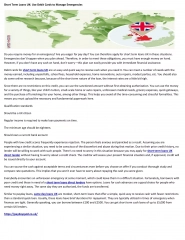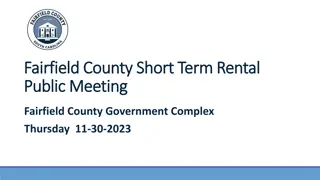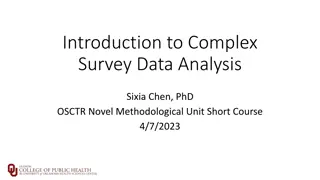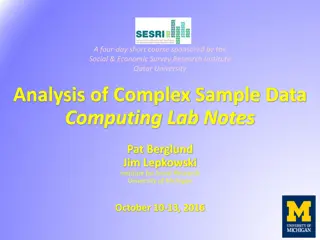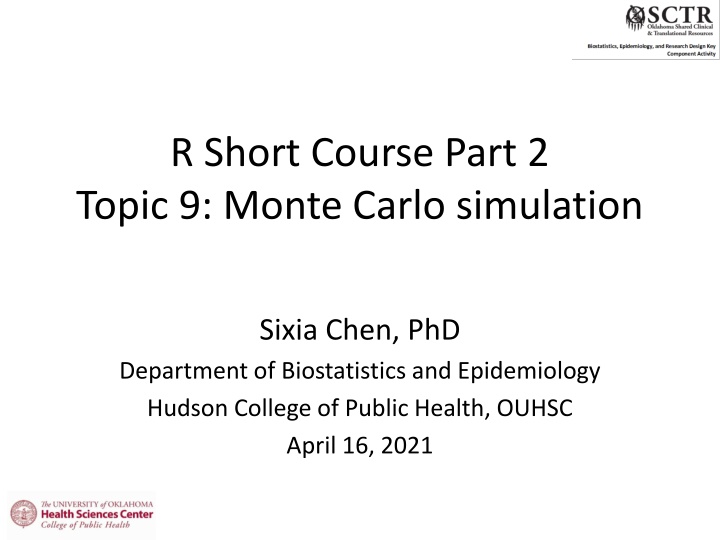
Monte Carlo Simulation: Distributions, Setups, and Sampling Methods
Explore Monte Carlo simulation with simulations from various distributions, setup options, and sampling techniques. Learn how to generate Monte Carlo samples and evaluate estimation criteria for point estimation. Dive into population parameters, statistical models, and more in this comprehensive guide.
Download Presentation

Please find below an Image/Link to download the presentation.
The content on the website is provided AS IS for your information and personal use only. It may not be sold, licensed, or shared on other websites without obtaining consent from the author. If you encounter any issues during the download, it is possible that the publisher has removed the file from their server.
You are allowed to download the files provided on this website for personal or commercial use, subject to the condition that they are used lawfully. All files are the property of their respective owners.
The content on the website is provided AS IS for your information and personal use only. It may not be sold, licensed, or shared on other websites without obtaining consent from the author.
E N D
Presentation Transcript
R Short Course Part 2 Topic 9: Monte Carlo simulation Sixia Chen, PhD Department of Biostatistics and Epidemiology Hudson College of Public Health, OUHSC April 16, 2021
Outline Simulations from different distributions Monte Carlo simulation setups Monte Carlo simulation examples One sample problem Two sample problem Linear regression Logistic regression 2
Simulation from some distributions Normal distribution rnorm(n, mean = 0, sd = 1) Example: rnorm(100, mean=1, sd=2) Chi-square distribution rchisq(n, df, ncp = 0) Example: rchisq(100, df=2) Exponential distribution rexp(n, rate = 1) Example: rexp(100, 2) 3
Simulation from some distributions t distribution rt(n, df, ncp) Example: rt(10,df=2) Uniform distribution runif(n, min = 0, max = 1) Example: runif(10, min=1, max=2) Gamma distribution rgamma(n, shape, rate = 1, scale = 1/rate) Example: rgamma(20, shape=1, rate=2) 4
Simulation from some distributions Bernoulli distribution Install R package Rlab rbern(n,prob) Example: rbern(10, 0.5) Binomial distribution rbinom(n, size, prob) Example: rbinom(10, 2, prob=0.5) Poisson distribution rpois(n, lambda) Example: rpois(20, 1) 5
Simulation from some distributions Multivariate normal distribution Install R package MASS mvrnorm(n , mu, Sigma) Example: mvrnorm(n=10, mu=c(1,2), Sigma=matrix(c(1,0,0,1),2,2)) Simple random samples: Without replacement: sample(1:10, 2, replace = FALSE) With replacement: sample(1:10, 5, replace = TRUE) 6
Monte Carlo simulation setups Population parameter of interest Population mean Population regression coefficient Population percentiles Population variance Statistical model setups Generate Monte Carlo samples For each sample, provide estimates Evaluation criteria Point estimation: Monte Carlo Bias, Standard error, Variance, Mean Squared Error, relative Bias, 7
Evaluation Criteria Point estimation Monte Carlo (MC) Bias (Bias) MC Standard error (SE) MC Mean Squared Error (MSE) MC relative Bias (RB) MC relative Standard error (RSE) MC relative root Mean Squared Error (RRMSE) 8
Evaluation Criteria Variance estimation MC relative Bias (VRB) MC Coverage rate (CR) MC Average length (AL) 9
Example 1: One sample problem Objective: evaluate the statistical property of estimator (sample mean) for estimating population mean Parameter: Population mean ?0= ?(?) Point estimator: sample mean ? = ? 1 ?=1 Variance estimator: Model distributions for ?: Normal distribution Chi-square distribution ? ?? 10
Simulation setups Generate B=2,000 Monte Carlo samples from the following two models: Normal model: ?(? = 1,?2= 1) Chi-square model with df=2 Parameters: ?0= 1 for normal model and ?0= 2 for Chi-square model Estimator: sample mean Variance estimator: ? ? = ? 1?2 with ?2 as the sample variance of ?1,?2, ?? 11
Evaluation Criteria-Point Estimation 1 ? ?=1 ?? ?0 ? ???? = 2, where ? = 1 ?? ? ? ?? = 1 ? ?=1 ??? = ??????2+ ????2 ?? = ??????/?0 ??? = ????/?0 ????? = ???/?0 ? 1 ?=1 ?? ? ?0 12
Evaluation Criteria-Variance Estimation ?? ??2/??2 ?(???< ?0< ???), where ? ??? = ? 1 ?=1 ?? = ? 1 ?=1 ??? and ??? are the lower bound and upper bound of confidence interval for sample ?. ???= ?? 1.96 ?? and ???= ??+ 1.96 ?? ?? = ? 1 ?=1 ??? ??? ? ? 13
Example 2: Two sample problem Parameter: Difference of two population means ?0= ? ?1 ?(?2) Models: ?1~?(?1= 2,?1 1,?2 Monte Carlo size: ? = 2,000 Sample sizes: ?1= ?2= 200 Point Estimator: ? = ?1 ?2 Variance Estimator: ? ? = 2= 1) and ?2~?(?2= 2= 1) 1 1 2 ?1+ ????? ?2 14
Example 3: Linear regression Model: ? = ?0+ ?1? + ?, where ?~?(0,1), ?~?(0,1), ?0= ?1= 1 Parameter: ?0 and ?1 Monte Carlo size: ? = 2,000 Sample sizes: n = 200 Point Estimator: Least square estimator Variance Estimator: Least square variance estimator 15
Example 4: Logistic regression Model: ? follows Bernoulli distribution with probability function logit ? = ?0+ ?1?, where ?~?(0,1), ?0= ?1= 1 Parameter: ?0and ?1 Monte Carlo size: ? = 2,000 Sample sizes: n = 200 Point Estimator: Maximum likelihood estimator Variance Estimators: Based on MLE and information matrix Bootstrap variance estimator 16
Bootstrap variance estimator Suppose we have a random sample ??,?? for ? = 1,2, ? Objective: inference for parameter ?0 Estimator based on sample ?: ?(?) Bootstrap sample ? : a simple random sample with replacement from original sample ? Estimator based on bootstrap sample ? : ?(? ) 17
Bootstrap variance estimator Variance estimator: Sample variance for ? bootstrap sample estimators ? 1 2 ? ? = ?(? (?)) ? ? 1 ?=1 95% Confidence interval: ? 1.96 ? ? , ? + 1.96 ? ? 18

